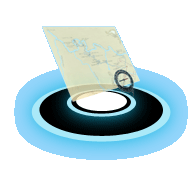While the compass is part of the scout’s Ten Essentials, I find that scouts will either forget to bring it or destroy it by
accidently dropping it off the side of a cliff. Either way, users should know how to find north without the aid of a compass
or a GPS unit. There are many methods to find north without a compass, a few are listed below:
- Watch Method
- Shadow-Stick Method
- Equal Length Shadow Method
- Stars
- Magnetic Needles
|
Watch Method
The Watch Method is one of the easier methods to use because it does not require anything except the watch on your hand. The Watch Method
is done with an analog watch (the one with hands!) and is done as follows:
1. Point the hour hand towards the sun.
2. Find the center point of the angle between the hour hand and the 12 o’clock mark on the face of the watch.
3. The center angle is the north-south line. Obtain the east-west line by remembering where the sun rose in the morning. The sun rises from the east.
Notes to keep in mind, in the event the watch is set to Daylight Savings Time, use the 1 o’clock mark instead of the 12. Furthermore, there are
limitations of this method. Users should keep in mind that this method may not be accurate and is not recommended in lower latitudes. If the scout is located
in the southern hemisphere point the watch's 12 o'clock mark toward the sun. The center angle between 12 and the hour hand will give you the north-south line.
|
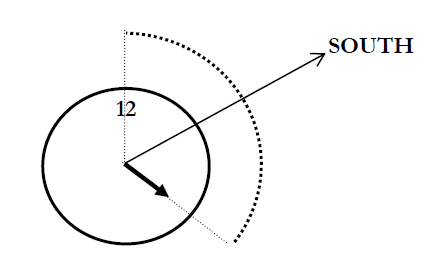
|
|
Shadow-Stick Method
The Shadow-Stick Method is a method that requires some patience. Follow the steps below to use the Shadow-Stick method.
1. Put a stick in the ground on a flat area and note where the stick’s shadow falls. Mark the tip with a rock.
2. Wait 15 minutes, and determine where the shadow has moved to. Mark where the new tip of the pole’s shadow with another rock.
3. Draw a line from the first rock to the second rock; this is your west-east line where your first mark is west and your second mark is east.
4. Stand with your left feet on the west mark and your right feet on the east mark. You will be facing north and your back will be facing south.
Since the sun travels from east to west the shadow cast by the stick will create a west-east line.
|
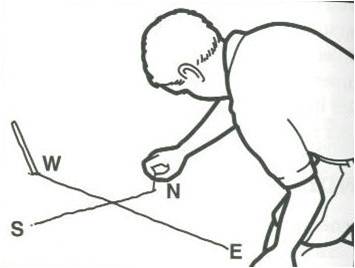
|
|
Equal Length Shadow Method
This method can only be used before noon, and the results would be more accurate the earlier the user starts. This is an extremely time
consuming method but will allow the user to determine north at the end of the day. Follow the steps below to use this method.
1. In the morning, drive a staff into the ground and then draw a circle around the staff. Using the shadow produced by the staff as the circle’s radius, mark where the shadow touches the circle as Point A.
2. Wait until the afternoon and check where the shadow of the staff touches the circle again and mark it as point B.
3. Draw a line from point A to point B. You have created your West-East line.
4. Stand with your left feet on the west mark and your right feet on the east mark. You will be facing north and your back will be facing south.
This can further be used to create a clock where the west point (point a) can be marked as 6:00 am and the east point (point b) be marked as 6:00 pm. However in order to create a 12 hour clock the scout would need to
dedicate the entire day so marking off the shadows of the stick.
|
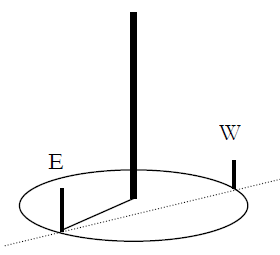
|
|
Oh look, pretty stars.
Stars have been used in navigation prior to the invention of compasses and GPS. By identifying different constellations, users can determine
the general direction of north and from there, the rest of the directions. The most common way to identifying north at night is to find Polaris,
or the North Star. Like any constellation based method for finding directions, this method can only be used during a clear night. Any overcast
will hinder the user’s ability to locate the proper constellation. The North Star resides within the Ursa Minor constellation, or more commonly
|
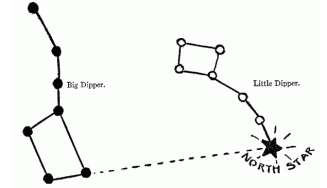
|
|
Due to its size, star gazers normally use Ursa Major, the Big Dipper, to locate the North Star. Once the constellation has been identified, follow the method listed below to create the north-south line.
1. Drive a pole at least 2 foot tall into the ground.
2. Hold another short stick in your hand and sight the North Star from the top edge of the 2 foot stick and the top edge of the short stick in your hand.
3. Drive the short stick into the ground and connect the short stick and the long stick by drawing a line. This is your north south line.
|
Home-made compasses?
Yes, you heard right. You can learn how to make your own compass at home, or in the wild. When you think about it, a compass is just a magnetic needle floating in water. Therefore if you have a needle and a magnet, then you would be able to create your own compass. Follow the steps below:
1. Prior to starting you would need a metal needle, a magnet, piece of paper or leaf, and a bowl to hold the water.
2. Start by magnetizing the needle. To magnetize the needle, take the magnet and stroke the needle in the same direction repeatedly.
3. Suspend the magnetized needle so it can move freely and place it in the bowl of water. This is where the paper or leaf comes in.
4. If done correctly, the needle will align itself to the North-south line.
As seen above, there are many ways to find north without the aid of a compass. You just have to be a bit creative and know some basic knowledge.
These are basic First Class requirements, so if you don't understand how it works, find a First Class Scout to ask.
|





